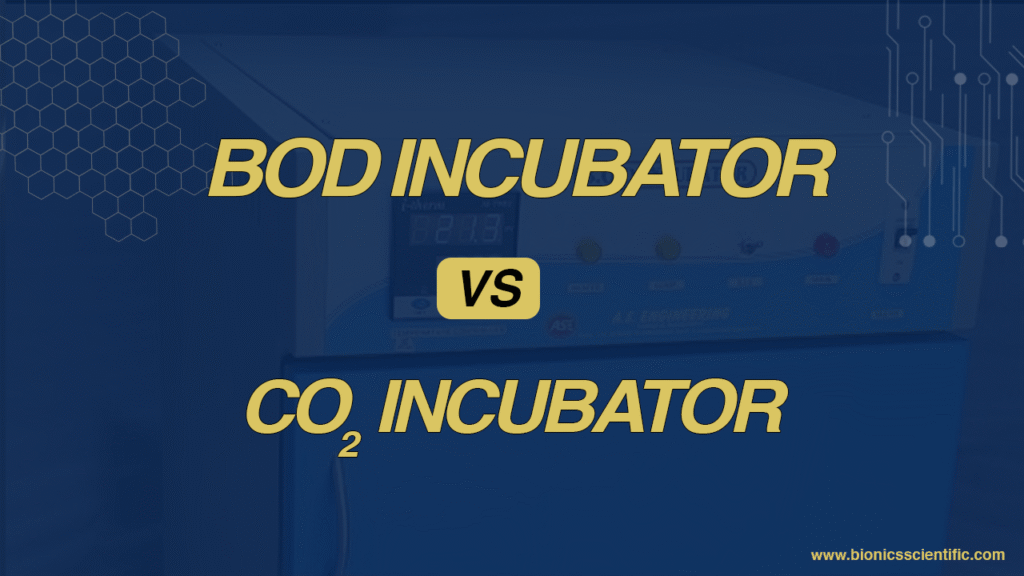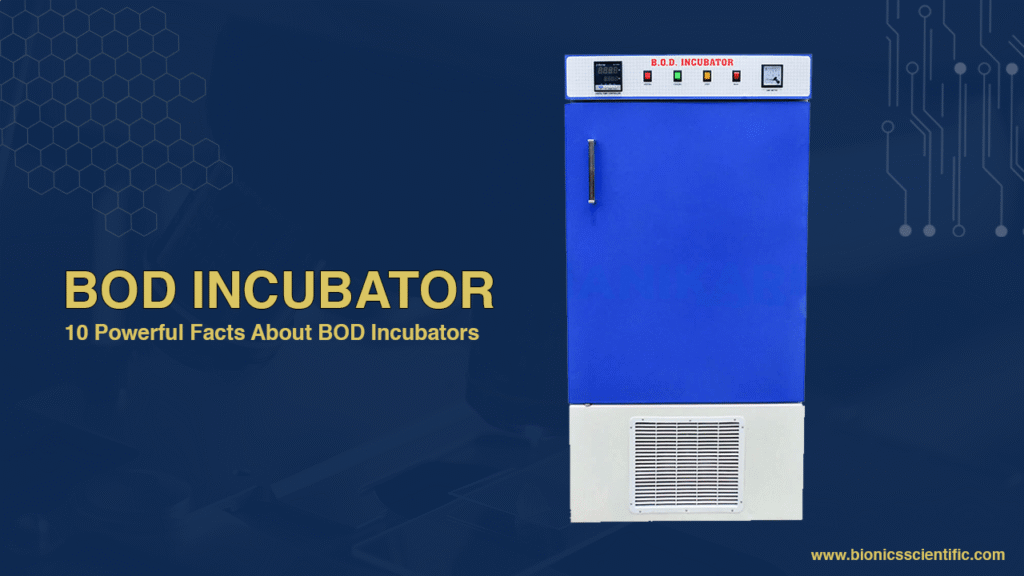BOD Incubator vs CO2 Incubator: Choosing an right incubator is crucial for getting accurate and reliable results in laboratory incubation, Among the commonly used BOD Incubators and the CO2 Incubators, While both CO2 Incubators and BOD Incubators mainly used to maintain a controller environment but they cater to diffirent applications
In this post, We will guide you with the key differences, applications, and usage of BOD and CO₂ incubators that help you choose the right incubators selection for your lab.
BOD Incubator vs CO₂ Incubator
What Is a BOD Incubator?
BOD Incubator, also known as Biochemical Oxygen Demand Incubator, is mainly designed to maintain a low-temperature environment, usually between 5°C and 60°C, with higher stability. A BOD (Biochemical Oxygen Demand) incubator is a specialized laboratory equipment used in measuring the amount of oxygen consumed by microorganisms in water or wastewater samples. The BOD test is a widely used method to determine the level of water pollution and the effectiveness of treatment processes.
A BOD incubator creates a controlled environment to support microbial activity during biochemical oxygen demand (BOD) testing. It maintains a steady temperature of 20°C, the standard required for accurate BOD analysis. The chamber is dark and sealed to block external light and air, ensuring that microorganisms rely solely on the oxygen present in the water sample.
The BOD test begins by measuring the sample’s initial dissolved oxygen (DO) level. The sample is then placed inside the incubator for five days. After incubation, the final DO level is recorded. The difference between the initial and final readings represents the BOD value, indicating how much oxygen the microorganisms consumed during that period.
BOD incubators often include an internal power socket, which allows users to operate devices like magnetic stirrers or sensors within the chamber. This feature supports continuous monitoring or controlled agitation without compromising the incubator’s sealed environment.
Main Features:
- Temperature control (typically 20°C ± 1°C for BOD tests)
- Ideal for long-duration incubations (up to 5 days or more)
- Designed to support aerobic biological tests
Common Applications:
- Water treatment: BOD tests are used to measure the effectiveness of water treatment processes, such as the removal of pollutants from wastewater.
- Environmental monitoring: BOD tests are used to measure the level of water pollution in rivers, lakes, and other bodies of water.
- Industrial monitoring: BOD tests are used to measure the impact of industrial processes on water quality.
- Research: BOD tests are used in research to study the growth and metabolism of microorganisms in water and wastewater samples.
What Is a CO₂ Incubator?
CO₂ Incubators are designed to create a physiological atmosphere, especially for mammalian cell growth. These incubators maintain temperature, humidity, and controlled CO₂ levels (typically 5%).
CO₂ incubators are specialized enclosures designed to maintain the controlled environment required for growing biological and cell cultures. While incubators serve multiple industries—including poultry and pharmaceutical development—CO₂ incubators are specifically used in life science and laboratory settings for cell culture applications.
These incubators regulate key parameters such as temperature, humidity, CO₂ concentration, and oxygen levels. Among these, controlling CO₂ is essential for maintaining the pH balance of the culture medium. The incubators often use CO₂ sensors to ensure that the gas concentration remains stable throughout the incubation period.
Maintaining a sterile and tightly regulated environment allows technicians and researchers to optimize cell growth, reduce contamination risks, and ensure the reproducibility of experimental results.
Main Features:
- Precise CO₂ control with sensors (IR or thermal conductivity)
- Humidified environment with temperature around 37°C
- HEPA filtration for contamination control
Common Applications:
- Cell culture (including stem cells and cancer cells)
- IVF procedures and embryo incubation
- Pharmaceutical testing
- Tissue engineering and regenerative medicine
Key Differences Between BOD and CO₂ Incubators
| Feature | BOD Incubator | CO₂ Incubator |
|---|---|---|
| Purpose | Biochemical Oxygen Demand and microbial tests | Cell and tissue culture |
| Temperature Range | 5°C to 60°C (commonly used at 20°C) | Usually fixed at 37°C |
| CO₂ Control | Not available | Available (3–10% CO₂) |
| Humidity Control | Basic (if available) | High humidity (to prevent cell drying) |
| Application Type | Environmental & water labs | Biomedical, pharma & biotech labs |
| Cost | More economical | Relatively expensive |
Which Incubator Should You Choose?
- Choose a BOD incubator if your work involves environmental testing, water analysis, bacterial culturing, or seed germination at low temperatures.
- Go for a CO₂ incubator if you’re working with sensitive cell cultures, tissue samples, or medical research requiring a CO₂-enriched and humidified environment.
Bionics Scientific: Your Partner in Lab Equipment
Whether you need a high-precision BOD incubator for wastewater testing or an advanced CO₂ incubator for cell culture, Bionics Scientific offers a wide range of reliable, ISO & CE-certified lab incubators designed for Indian labs and international standards.


